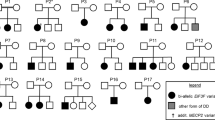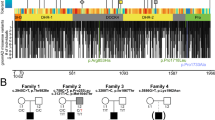Abstract
Feingold syndrome is characterized by variable combinations of esophageal and duodenal atresias, microcephaly, learning disability, syndactyly and cardiac defect. We show here that heterozygous mutations in the gene MYCN are present in Feingold syndrome. All mutations are predicted to disrupt both the full-length protein and a new shortened MYCN isoform, suggesting that multiple aspects of early embryogenesis and postnatal brain growth in humans are tightly regulated by MYCN dosage.


Similar content being viewed by others
References
Torfs, C.P. et al. Teratology 52, 220–232 (1995).
Merei, J.M. & Hutson, J.M. Pediatr. Surg. Int. 18, 319–326 (2002).
Celli, J. et al. Am. J. Hum. Genet. 66, 436–444 (2000).
Celli, J. et al. Am. J. Med. Genet. 122A, 294–300 (2003).
Dib, C. et al. Nature 380, 152–154 (1996).
Litingtung, Y. et al. Nat. Genet. 20, 58–61 (1998).
Kenney, A.M. et al. Development 130, 15–28 (2003).
Oliver, T.G. et al. Proc. Natl. Acad. Sci. USA 100, 7331–7336 (2003).
Dang, C.V. et al. Proc. Natl. Acad. Sci. USA 89, 599–602 (1992).
Nair, S.K. et al. Cell 112, 193–205 (2003).
Jopling, C.L. & Willis, A.E. Oncogene 20, 2664–2670 (2001).
Hirvonen, H. et al. Oncogene 5, 1787–1797 (1990).
Stanton, B.R. et al. Genes Dev. 6, 2235–2247 (1992).
Moens, C.B. et al. Genes Dev. 6, 691–704 (1992).
Knoepfler, P.S. et al. Genes Dev. 16, 2699–2712 (2002).
Acknowledgements
We thank the families for contributing material for this study; R. Carozzo, W. Courtens, M. Frydman, P. van Galen, R. Hennekam, H. Kingston, R. Koenig, A. Norman, L. Piersall, T. Prescott and R. Winter for making materials available to us; J. Schouten for the oncogene MLPA kit; and G. Vriend for making the MYCN structural model. This work was supported by grants from the ZON-MW and the Maag Lever Darm Stichting.
Author information
Authors and Affiliations
Corresponding author
Ethics declarations
Competing interests
The authors declare no competing financial interests.
Supplementary information
Supplementary Fig. 1
Heterozygous MYCN mutations in Feingold syndrome patients. (PDF 29 kb)
Supplementary Fig. 2
Predicted protein structure of the B-HLH/Leu-Z domain of MYCN. (PDF 215 kb)
Supplementary Fig. 3
Segregation of the R373X mutation in a large FS family. (PDF 23 kb)
Supplementary Fig. 4
MLPA-based microdeletion analysis of the MYCN gene. (PDF 18 kb)
Supplementary Fig. 5
MYCN immunoblot analysis of human fetal tissues. (PDF 33 kb)
Rights and permissions
About this article
Cite this article
van Bokhoven, H., Celli, J., van Reeuwijk, J. et al. MYCN haploinsufficiency is associated with reduced brain size and intestinal atresias in Feingold syndrome. Nat Genet 37, 465–467 (2005). https://doi.org/10.1038/ng1546
Received:
Accepted:
Published:
Issue Date:
DOI: https://doi.org/10.1038/ng1546
- Springer Nature America, Inc.
This article is cited by
-
Ätiologische Konzepte von gastrointestinalen Fehlbildungen/Atresien
Monatsschrift Kinderheilkunde (2023)
-
Mouse models of pediatric high-grade gliomas with MYCN amplification reveal intratumoral heterogeneity and lineage signatures
Nature Communications (2023)
-
A Novel MYCN Variant Associated with Intellectual Disability Regulates Neuronal Development
Neuroscience Bulletin (2018)
-
The MRN complex is transcriptionally regulated by MYCN during neural cell proliferation to control replication stress
Cell Death & Differentiation (2016)





